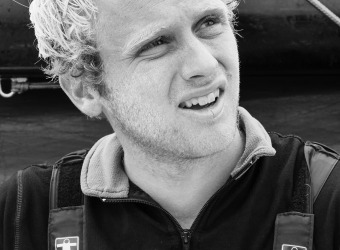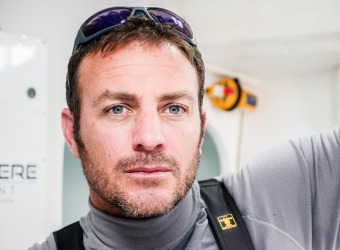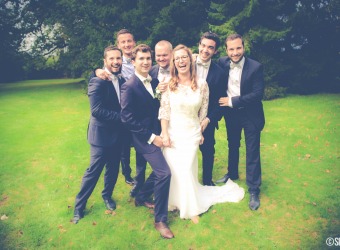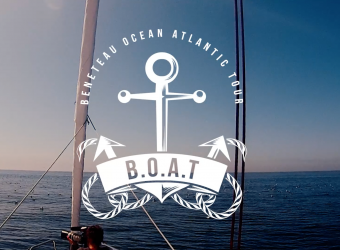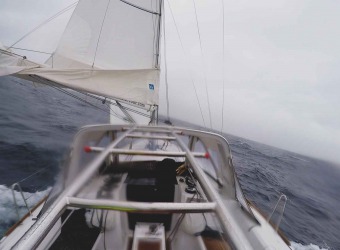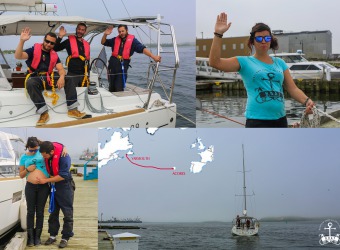Le projet
OBJECTIF : 12 000 milles autour de l'Océan Atlantique
L'HISTOIRE

Petit-fils de Benjamin Bénéteau, j'ai décidé, à l'occasion des 130 ans du groupe Bénéteau, de prendre la mer pendant une année pour parcourir l'Océan qui borde mon pays natal : la Vendée. J'ai choisi la boucle de l'Atlantique Nord car c'est le parcours le plus adéquat à un voyage d'une durée d'un an. Je pense également que c'est un tour intéressant pour découvrir différents paysages du Monde.
Pour mener à bien la communication de ce projet et pendant le Tour, j’ai la chance d’être assisté de mon amie Aurélie. Gérante de la société Simeli production depuis 5 ans, spécialisée dans le suivi de courses au large et de chantier naval tel que Bénéteau, elle a déjà réalisé de nombreux films pour le monde de la voile.
En associant nos savoir-faire, nous essaierons de vous faire partager notre expérience à travers des témoignages photos et vidéos au quotidien. Nous prévoyons également en fin de parcours de proposer un 52 minutes innovant sur cette célèbre route Nord qui pour l’instant n’est pas expliquée ou illustrée sur le web ni sur le support DVD.

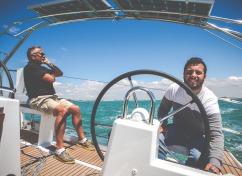
LE PARCOURS
Christophe Colomb fut le premier à accomplir la boucle de l’Atlantique Nord et notre itinéraire est en grande partie basé sur son propre voyage en 1492-1493. Seule la fin de l'itinéraire est différente : nous suivrons celle empreintée par les Vikings en espérant une escale au Groénland si la météo le permet.
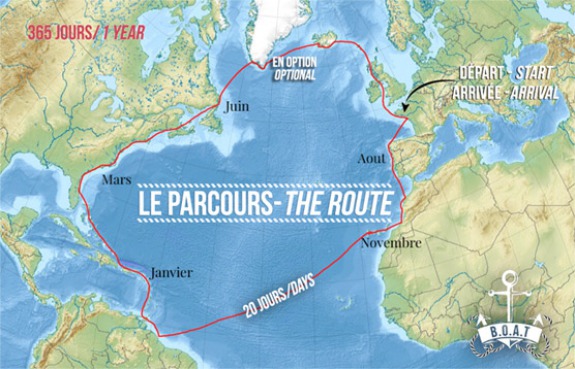 Lorsque l’on projette une traversée, l’important est d’utiliser au mieux les vents favorables et les conditions météo en choisissant la route qui réduira au maximum les risques de rencontrer du mauvais temps. C’est le cas de cette boucle de l’Atlantique Nord. En partant au mois d’août de France, nous profiterons d’un temps clément pour traverser le Golfe de Gascogne, descendre le long de la péninsule Ibérique avant de partir vers les Canaries et le Cap Vert. La traversée de l’Atlantique se déroulera en novembre ou début décembre, par la route des alizés, nous permettant d'arriver aux Antilles avant la fin de l’année. Nous évitons ainsi la saison des cyclones dans l’Atlantique ouest de juin à novembre. Ensuite, le bateau pourra passer une partie de l’hiver dans les Antilles. La remontée des États Unis via l’intercostal sera réalisée simultanément avec l’arrivée du printemps et des beaux jours (mars à mai) pour être à Terre Neuve aux alentours du mois de juin. Selon les conditions climatiques, nous emprunterons une route via le Groenland, l’Iceland et l’Irlande ou ferons route directe vers la France depuis Terre-Neuve en profitant des vents d’Ouest.
Lorsque l’on projette une traversée, l’important est d’utiliser au mieux les vents favorables et les conditions météo en choisissant la route qui réduira au maximum les risques de rencontrer du mauvais temps. C’est le cas de cette boucle de l’Atlantique Nord. En partant au mois d’août de France, nous profiterons d’un temps clément pour traverser le Golfe de Gascogne, descendre le long de la péninsule Ibérique avant de partir vers les Canaries et le Cap Vert. La traversée de l’Atlantique se déroulera en novembre ou début décembre, par la route des alizés, nous permettant d'arriver aux Antilles avant la fin de l’année. Nous évitons ainsi la saison des cyclones dans l’Atlantique ouest de juin à novembre. Ensuite, le bateau pourra passer une partie de l’hiver dans les Antilles. La remontée des États Unis via l’intercostal sera réalisée simultanément avec l’arrivée du printemps et des beaux jours (mars à mai) pour être à Terre Neuve aux alentours du mois de juin. Selon les conditions climatiques, nous emprunterons une route via le Groenland, l’Iceland et l’Irlande ou ferons route directe vers la France depuis Terre-Neuve en profitant des vents d’Ouest.
LE BATEAU
"L'OURS BLANC"* - Coque 64 millésime - Océanis 38 -

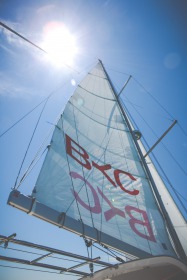
La réputation de Bénéteau en terme de qualité, de design et de modernité n’est plus à faire, mais lorsqu’on parle de grande croisière, les clients ont souvent l’habitude de se tourner vers des constructeurs de voiliers en aluminium qu’ils estiment dédiés à la navigation “grand large”.
C’est de cette problématique que mon projet de navigation autour de l’Atlantique Nord est né. Ma volonté première est de montrer qu’une nouveauté Bénéteau de taille moyenne en polyester est tout à fait capable de naviguer aussi bien sous le soleil des tropiques que dans les glaces du Groenland*.
Dans cette perspective, mon choix s’est tourné vers le nouveau OCEANIS 38 qui associe une image d’aventure, de sportivité et de plaisir en mer.
Skipper diplômé de Marine marchande, j’ai l’envie et la capacité d’emmener ce bateau tout au long d’une année à la rencontre de ports étrangers et de paysages multiples.
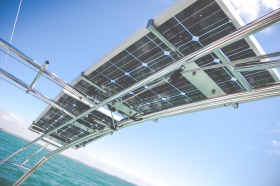 Nous avons équipé le bateau de panneaux solaires pour avoir de l’énergie à tout moment. Nous disposerons d’une antenne Wifi pour internet lors des escales et de tout le matériel de sécurité obligatoire.
Nous avons équipé le bateau de panneaux solaires pour avoir de l’énergie à tout moment. Nous disposerons d’une antenne Wifi pour internet lors des escales et de tout le matériel de sécurité obligatoire.

(* Le bateau a comme nom de naissance " L'ours Blanc" car notre objectif le plus risqué est d'atteindre le grand Nord et d'y voir (si tout se passe miraculeusement bien...) un ours blanc. Et puis avouez que notre bateau ressemble beaucoup à cet animal :) Il y a aussi le pingouin... enfin ça c'est une autre histoire...)
----------------------------------------------------------------------------
English version : 12,000 miles around the Atlantic Ocean
The story
As grand-son of Benjamin Beneteau, and for the 130th birthday of the Beneteau group, I decided that for one year, I would sail around the ocean bordering my home area: the Vendée. I chose the loop of the North Atlantic as it is the most suitable for a one-year trip. I also think it is an interesting tour to discover different landscapes of the world. To carry out the communication of this project and during the Tour, I am fortunate to be assisted by my girlfriend Aurélie. Manager of the company Simeli Production for 5 years, specializing in monitoring offshore races and shipyards as Beneteau, she has already made numerous films covering the sailing world. By combining our expertise, we will do our best to share our experiences through daily testimonials on photos and videos. At the end of the Tour, we also wish to to provide an innovative 52 minutes video of the famous North road, not yet explained or illustrated on the web nor on DVD.
The journey
Christopher Columbus was the first to complete the loop of the North Atlantic and our itinerary is largely based on his own journey in 1492-1493. Only the end of the route differs : we will follow the one of the Vikings, hoping for a stopover in Greenland if the weather permits. When planning a transatlantic, the most important is using the best favorable winds and weather conditions by choosing the route which will minimize the risk of encountering bad weather. This is the case of the loop of the North Atlantic. Starting in August from France, we should encounter good conditions to cross the Gulf of Biscay, down along the Iberian peninsula before heading to the Canary Islands and Cape Verde. The Atlantic crossing will take place in November or early December, according to trade winds, allowing us to reach the West Indies before the end of the year. We thus avoid the hurricane season in the western Atlantic from June to November. Then the boat will spend part of the winter in the Caribbean. We should then head to the U.S. via the intercostal with the arrival of spring and sunny days (March to May) to be in Newfoundland around June. Depending on the weather, we could take a route via Greenland, Iceland and Ireland or would direct route to France from Newfoundland enjoying westerly winds.
The ship
Beneteau reputation in terms of quality, design and modernity is already well known, but when it comes to cruising, customers often have a habit of turning to aluminum sailboat builder dedicated to offshore sailing. My first wish is to show that a new Beneteau midsize polyester boat is able to sail in tropical sunny areas, as well as in Greenland ice *. In this perspective, my choice turned to the new Oceanis 38 which combines adventure, sportsmanship and fun at sea. Skipper graduate in Merchant Marine, I have the desire and the ability to take this boat throughout one year to discover foreign ports and multiple landscapes. We have equipped the boat with solar panels for energy at any time. We will have a wireless internet antenna during stopovers and all mandatory safety equipment.
http://www.beneteau.co.uk/Sailing-Yachts/Oceanis/Oceanis-38
*The boat as birth name "White Bear" because our riskiest goal is to reach the far north and see (if all goes well ... miraculously) a polar bear. And agree that our boat looks like this animal :) There is also the penguin ... but that's another story ...)
Facebook } BOAT
Instagram } @boat_trip_family
Photos & Vidéos

